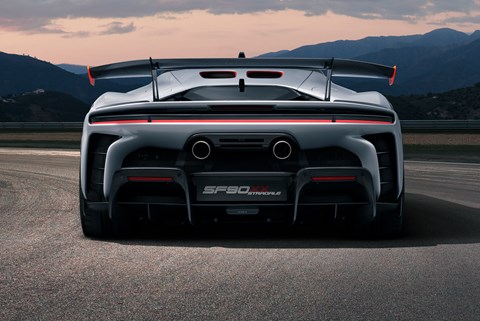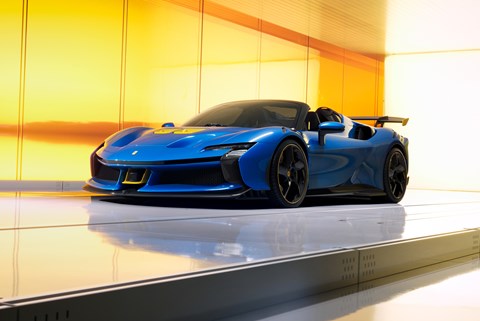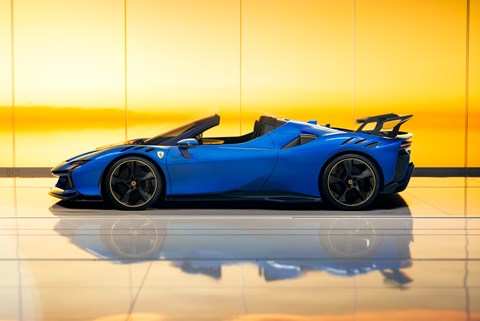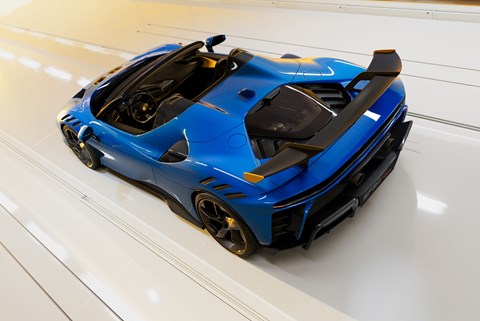► Ferrari’s extreme SF90 XX revealed
► 1016bhp super-hybrid ups the ante
► And, as you’d expect, they’re sold out
Ferrari’s bright-eyed chief development driver, Raffaele di Simone, is in confessional mood regarding the new SF90 XX, telling me with a wry smile: ‘For the first time I can remember I did not go into a project asking for more power. You will agree, the SF90 has already a lot…’
986bhp, the ‘standard’ SF90’s system total is, I agree, a lot. More than enough – until, of course, someone decides that it isn’t. Someone like Ferrari’s marketing and commercial boss Enrico Galliera, for example. He woke one day convinced the SF90 needed a more powerful, hardcore variant with a margin of superiority worthy of XX badging and pricing.
Raffa looks a little weary, as do Ferrari’s department leads, chief development officer Gianmaria Fulgenzi and Flavio Manzoni, Maranello’s charismatic head of design. And found more power they have, of course – 30bhp, to elevate that total to 1016bhp (786bhp from the twin-turbo V8, 230bhp from the hybrid system).
And that modest power increase speaks a thousand words. This car wasn’t easy. The team’s weary because the SF90 XX looks an awful lot like hard work – a long-hours trek into the wilderness of diminishing returns. For roughly twice the asking price of an SF90, the XX delivers another 30bhp and a 10kg weight saving. Most of us could find 10kg skipping breakfast for a month, and if you’re regularly rinsing your 986bhp SF90 for all it can give, wishing it had another 30 ponies, the Scuderia would love to hear from you.

Manzoni once likened the relationship Ferrari has nurtured between departments as like playing in a jazz band; a virtuoso jam in which greatness just happens because everyone’s on the same wavelength, grooving to the same rhythm. The SF90 XX looks more bull in a music shop: a frenzied scramble to meet near-impossible demands, the three of them slaves to a brief so daunting you’d have forgiven Fulgenzi, Di Simone and Manzoni if they’d ‘accidentally’ deleted the incoming email and moved on.
The task, in the words of Galliera: ‘Combine the best of our road cars with the best of our racing experience [the SF90 XX cars emerges from the same high-performance think-tank that sired machines like the 499P Le Mans winner and the 296 GT3 car] to create a unique car that is basically a racing car but road-legal, to reward our most special clients. This is a new concept, never before developed by Ferrari, bringing together the best of the Special Series [by definition standard bearers for performance and technology in themselves] together with the extreme performance of the XX.’
What’s more, while undeniably potent, the standard SF90 is neither a particularly light nor simple conveyance. And neither is it one that’s attracted anything like the same rapturous feedback as, say, the LaFerrari or the 296 GTB, Maranello’s other two adventures in hybridisation. The SF90 is fast, yes, but with its complex three-motor hybrid drive, it’s also a car many people just don’t get. Indeed, the new coupe’s very name, XX Stradale, speaks to the contradiction at the heart of this thing: stradale, for street, and XX, previously a byword for engineering too extreme for the street…

With the XX name – and XX pricing – comes pressure. The new car can’t be a smidge better than the €428k (£380k in the UK) SF90 Stradale when the XX coupes (799 will be built, starting Q2 next year) are priced at €777,000 (no UK price yet), and the Spiders (599 units, into production Q4 2024) an even punchier €850,000.
How, exactly, has the XX been keeping Fulgenzi (engineering) awake at night?
Finding enough performance to justify the price, mostly.
Let’s talk power. The SF90 XX’s system total is a cool 1016bhp, up from 986bhp. On the combustion-engine side, Fulgenzi’s team’s been busy hot-rodding the 4.0-litre twin-turbo V8 in commendably old school style. To all but hit the magical 200hp per litre mark (in Italian money at least), the XX sports re-designed combustion chambers, new pistons, and cylinder heads lovingly polished and gas-flowed to within an inch of their CNC-machined lives (3.5kg’s also been shorn from the engine just by machining away anything considered vaguely surplus). Compression ratio is also up, to 9.54:1, the corresponding increase in engine temperature countered by teasing 5% more efficiency from the cooling system.
More performance has been extracted from the hybrid system by improving the cooling, letting Fulgenzi and chums work the motors and battery harder. Located between the two high-temperature radiators up front, the electrical system’s medium-temperature radiator’s been flipped over. Instead of sending hot air under the car, it now pours out through an S-duct over the top of the car, the better to keep it from finding its way into the intercoolers positioned at the car’s hips. What’s more, a now smooth front floor means 20% more front downforce, to help balance the hefty increase brought about by the big rear diffuser and that serious fixed rear wing. Overall downforce is a claimed 530kg at 155mph.
Given power and weight proved tough to shift in the right direction, Fulgenzi’s also looked to downforce and braking performance to make the difference.
‘The aerodynamics are a key element of any XX car,’ he explains. ‘We worked a lot on this, believe me – there is not one square centimetre on the car that is not shaped by aerodynamics. And we have for the first time in a long time this incredible, high-performance rear wing, because Raffa is always pushing to have more downforce and grip, because more downforce and grip mean increased performance and driving experience.’

Downforce without drag is the real secret sauce, of course, and to that end Fulgenzi’s squad’s come up with an active Gurney flap. Comprising a broad slot gap and a movable element controlled by actuators, the element is raised on the straights, opening the slot, cutting drag and helping the car warp between corners with unchecked haste. ‘And when it’s closed,’ Fulgenzi explains, ‘the air is pushed up, onto the rear wing, pushing the car down with the same force – Newton’s third law. The force of this system together with the wing is 315kg – 110kg more than the SF90.’
To compress braking zones and bleed them effortlessly into each corner, the braking system gets new pads, discs and some hefty upgrades to its brain. ‘We had to work strongly on vehicle dynamics to push the car on the edge in terms of control and behaviour,’ says Fulgenzi. ‘ABS Evo is an evolution of our hardware and software that works together with a new sensor we call 6D – 6D because it is able to measure perfectly the speed and the acceleration on the car in all three dimensions. This means we can detect the force on every wheel, not just the slip, so the braking system is able to react instantaneously in every single corner to increase performance and to reduce the braking distance.’
And having gone into a corner faster than you ever thought possible, carrying more brake than you ever considered sensible, the XX promises to then thump out of it unlike anything you may have driven previously. Fulgenzi’s added a boost function to the hybrid unit – slugs of e-power (30 tokens run in an arc across the driver’s display, giving a visual prompt as to how many of your chips you’ve cashed in) that help drive the XX harder out of key corners using ‘F1-derived calibration’.
So, job done? For that all-important Fiorano lap time we must wait. But the XX arrives with some impressive figures. All that power, together with all-wheel-drive traction (no mechanical connection, of course, but there’s an electric motor on each front wheel) bring about predictably shattering acceleration: 0-62mph in 2.3sec, 0-124mph in the same time it took the Mondial of the ’80s to go 0-60mph (6.5sec), and a 199mph top speed.

In philosophy and design concept, particularly its re-worked ‘long-tail’ rear, the SF90 XX calls to mind McLaren’s lauded LT series (not to mention Porsche’s RS GT cars), albeit with a very different business model. Woking’s LT’s command a modest premium; the XX’s price is an order of magnitude juicier than the base car’s.
But it is perhaps the Lamborghini Revuelto that really helps ground the new XX’s performance in some kind of plane of reference. The Lamborghini’s V12 makes 813bhp and the entire powertrain system, a tri-motor hybrid like the SF90, 1000bhp, for 0-62mph in 2.5sec. (At 1660kg dry, the V8 SF90 is a good deal lighter, and therefore quicker off the line, than the 1772kg Lamborghini).
Factor in the XX’s downforce and NASA-spec ABS Evo brakes and how might it go around Ferrari’s storied test track? 2014’s LaFerrari-based FXX-K did a 1min 14 and the SF90 Stradale a 1min 19… The road legality of the latter together with the racetrack potency to humble the former would be a marketing message forged in gold. But mapping the Amazon’s lost city of Z is easier than finding five seconds around Fiorano…
How, exactly, has the XX been keeping De Simone (development engineer and test driver) awake at night?
Making a 1016bhp street-legal monster safe and drivable, mainly.
The downforce helps, of course, as do electronics such as Ferrari Dynamic Enhancer 2.0 and the new ABS system. But Raffa’s also fought like a lion to try to keep the XX simple from a driver’s perspective, to make it communicative and to make it fun. After all, lose sight of that and you may as well give up and go home.
For example, the Gurney and boost features are both automated. While it must have been tempting to go scattering the steering wheel with primary-coloured buttons, F1 style, Raffa forbade it. The car knows when it can and should boost (the required conditions are the pedal flat to the floor and sufficient grip and e-power), just as it knows when to stall the rear wing and when to blow it. So, the car does the thinking – you’re busy enough as it is.
And while roll stiffness and spring rates are increased (passive dampers with titanium springs and a bespoke tune are standard; adaptive dampers are optional, and the car can be had with a nose lift), Raffa insists this is still a car that’ll work on the road, and that drivers will be able to get their very lucky heads around. To help, he’s even slowed the steering’s initial off-centre response, the better to build that driver confidence so key to exploiting a car this potent.

‘Since the first hours in the driving sim we focused on two things; re-creating the driving experience of a racing car and giving the driver the confidence to push the car at the limit,’ says De Simone. Over and above the numbers, it’s about giving the car the playfulness of a great Ferrari road or race car. It’s everything: a chassis that gives you feedback on handling and grip, a feeling of balance under braking, the speed of turn-in, lag-free power, the way the engine and gear-shifting sound…’
Right on cue, Raffa plays a recording of the XX going through a handful of gears – a short, sharp sonic barrage of high-revving V8 and hard-working turbos punctuated by heavyweight gear-shift events. It’s a hard-hitting riposte to those who claim the SF90 lacks character or drama, the twin-clutch gearbox shifting fast and hard as the V8 momentarily brings about peak cylinder pressure for a gearchange you feel as much as hear, we’re told.
Fulgenzi: ‘We have pushed the gearshift to create a racing experience – that bam-bam-bam that is incredible. We never have a shift like this before. I tested it a lot and I was shifting gear even when I didn’t need to shift gear… We increase the pressure inside the combustion chamber to the maximum when you shift gear, so when you shift you hear the bam, bam-bam… It’s a product of engine and transmission calibration, and it’s partly about performance but it’s also about driving thrills.’
How, exactly, has the XX been keeping Manzoni (design) awake at night?
By threatening to become butt ugly, so lofty were the performance targets.
Manzoni brought Ferrari design in-house because there was no other option – you can’t create machines as integrated, as potent and as beautiful as the LaFerrari unless design and engineering are integrated and perfectly synchronised. The gorgeous 499P Le Mans winner is proof of the man’s skills when it comes to making even highly regulated, aero-is-everything race cars beautiful, but the XX wasn’t far behind it as a design challenge…
‘Every time we start on a new project with engineers and aerodynamicists, the technical model you see – which represents the very best we can achieve from a performance standpoint – it is ugly. Fortunately, we are able to change this a lot because of the level of symbiosis we have, and because we designers have become quite expert in terms of aerodynamics. And then we can share and explore ideas with the aerodynamics and together transform this shape into something beautiful without losing the performance.’

Though the SF90 marks the return of a fixed wing on a Ferrari road car for the first time since the F50, Manzoni resisted the urge to go for a similar, smoothed-in wing design. In profile the car becomes too rear-heavy, he argues, and makes the car appear tall. Instead, his team worked to make the SF90 XX appear lower, losing the standard car’s rear lights and replacing them with a slender light bar that completely transforms the rear aspect. The net result is still recognisably SF90 but leaner, more heavily louvred, more purposeful.
It is not, perhaps, a car as beautiful as the LaFerrari or Roma. But it’s an oil painting next to original XX car, the Enzo-based FXX, and proof that high-performance aero and elegance needn’t be mutually exclusive.
How, exactly, has the XX been keeping Galliera (commercial and marketing) awake at night?
It hasn’t. Enrico sleeps like a baby. All 1398 SF90 XXs were sold before most of us knew it existed.